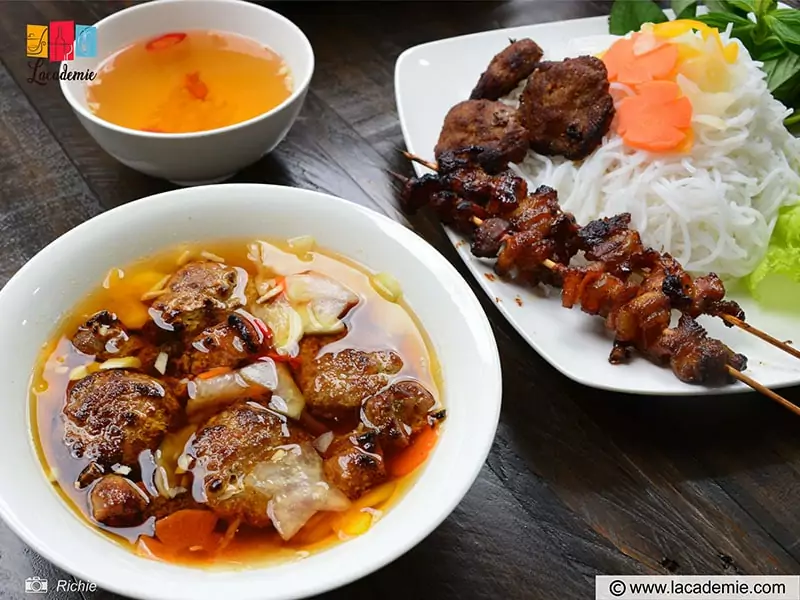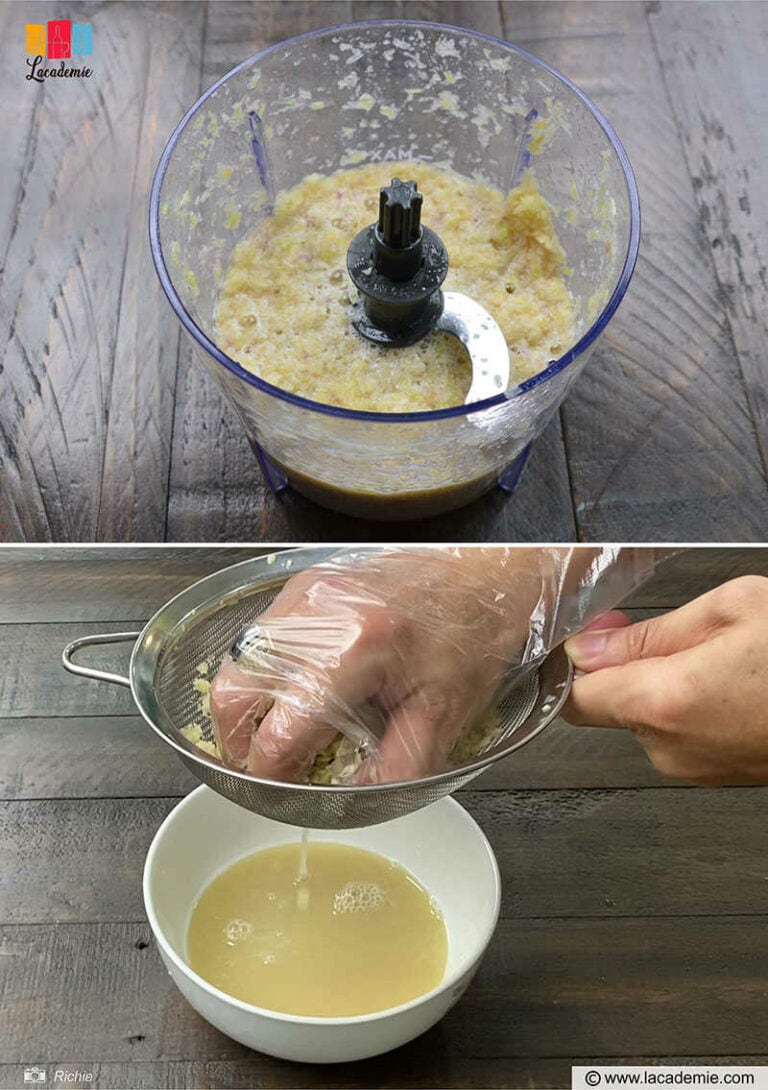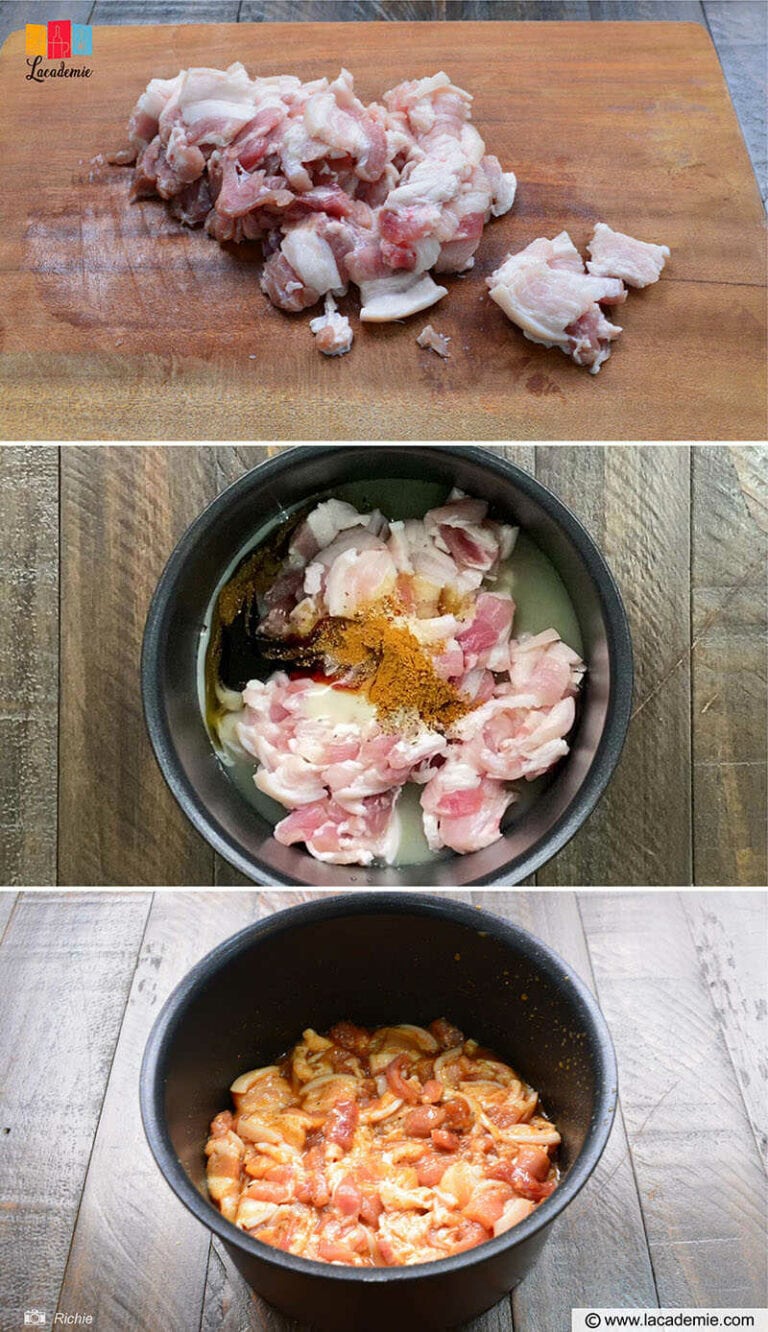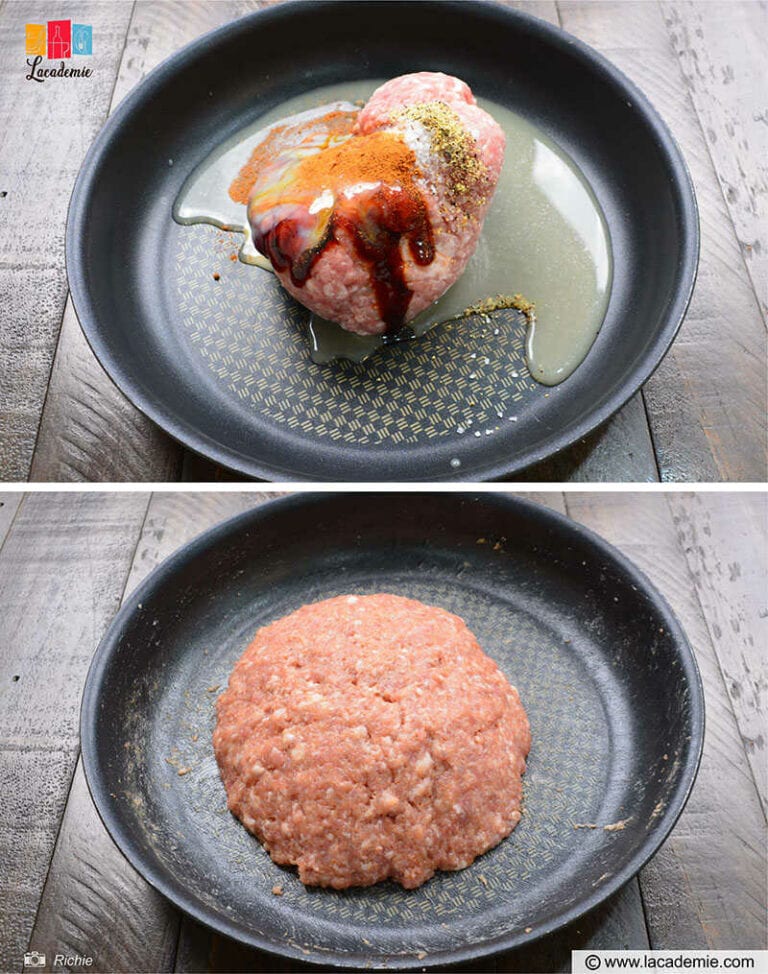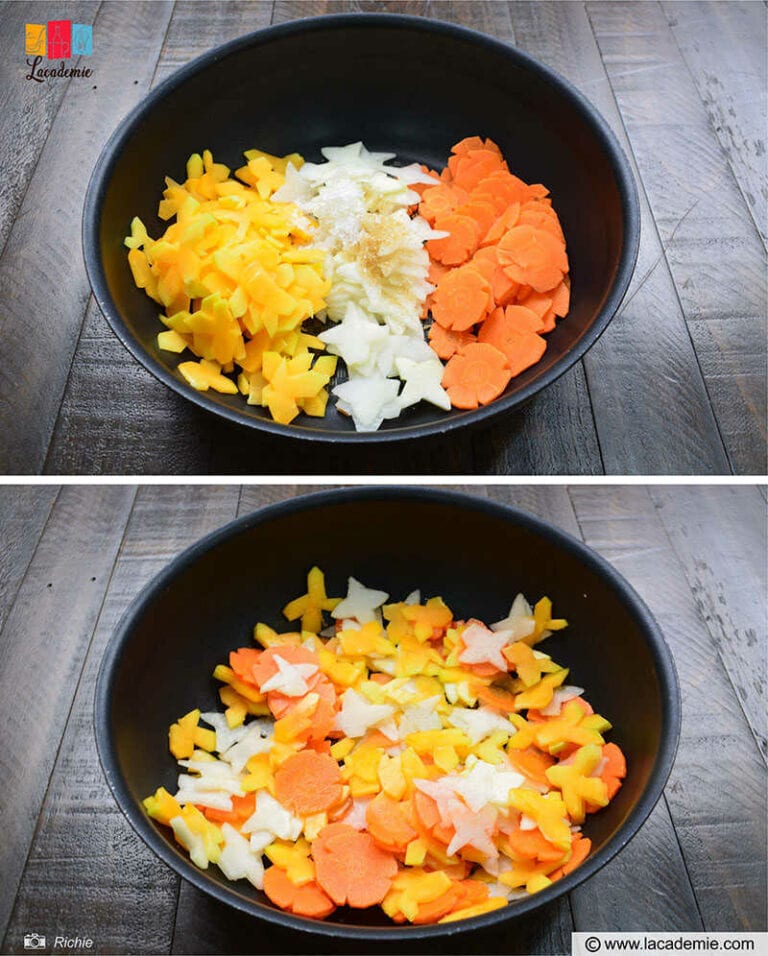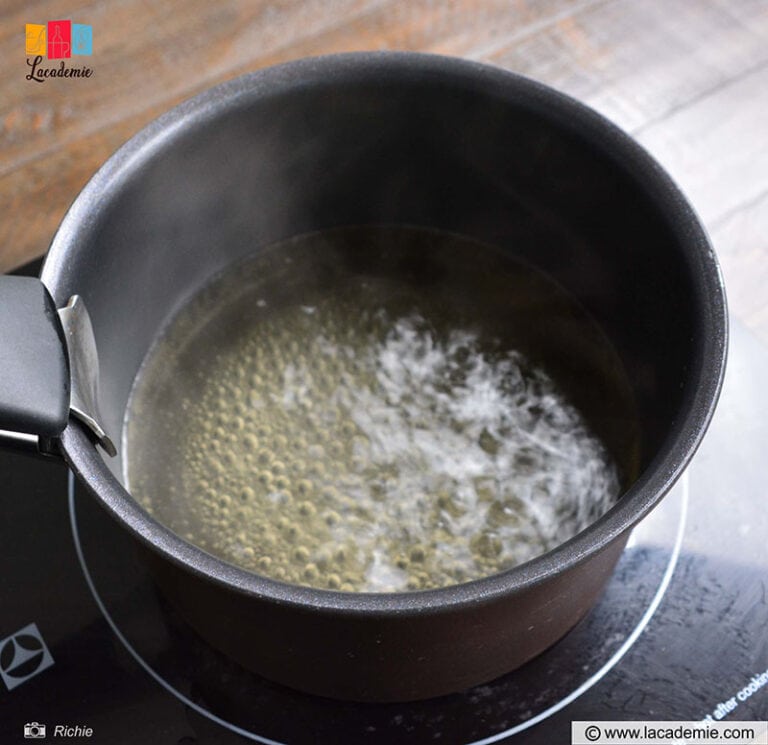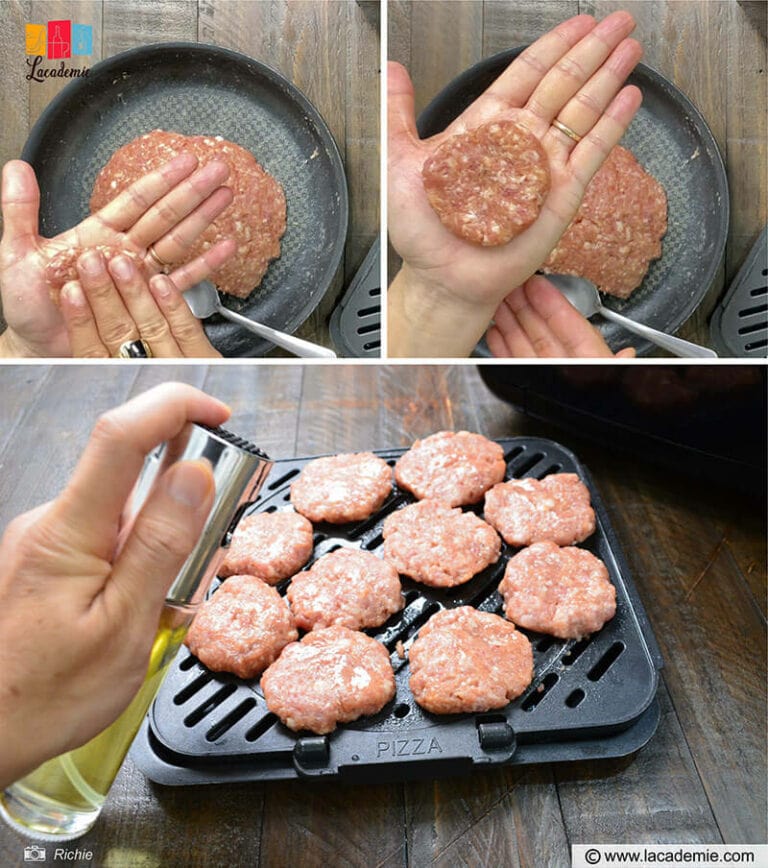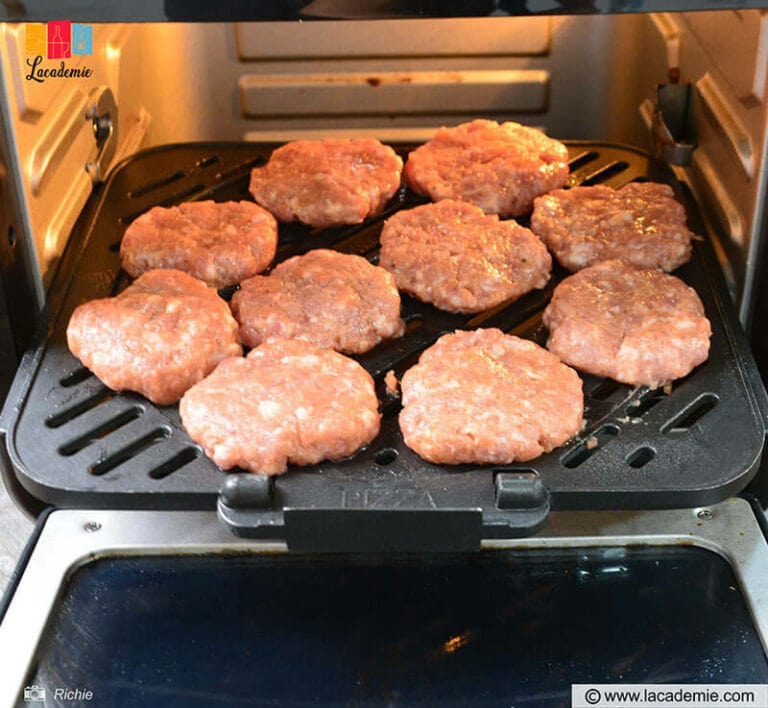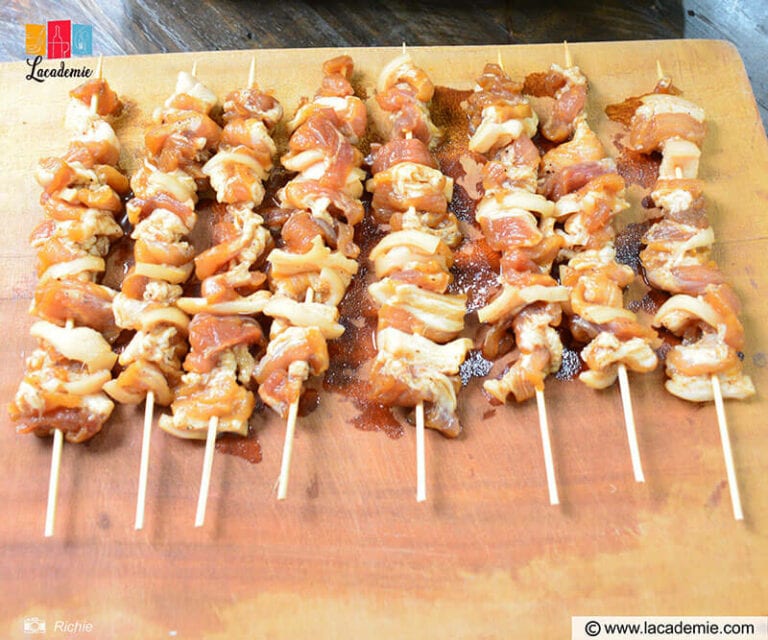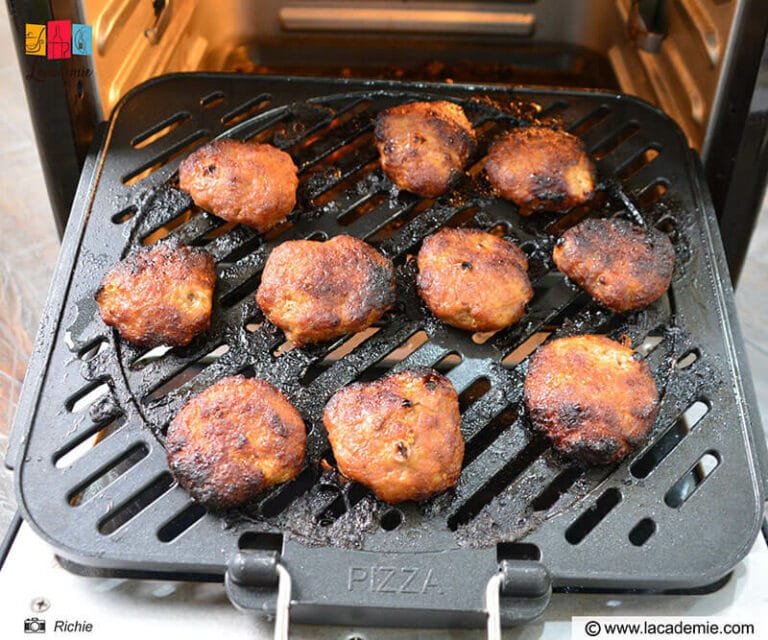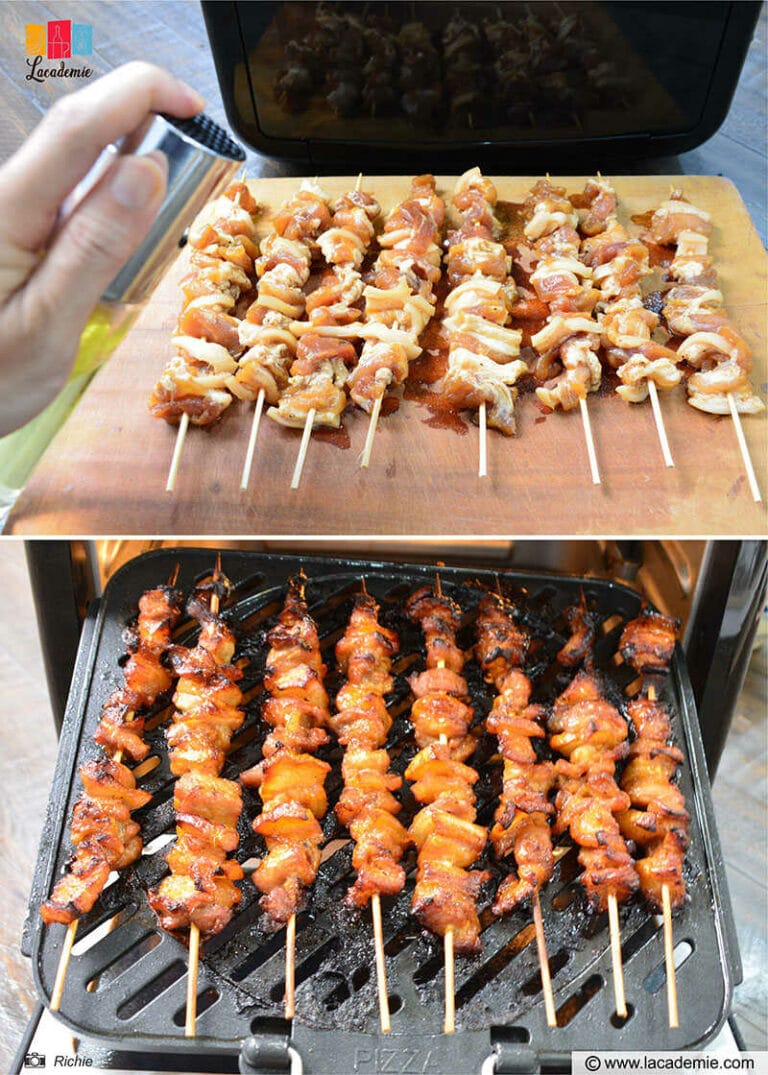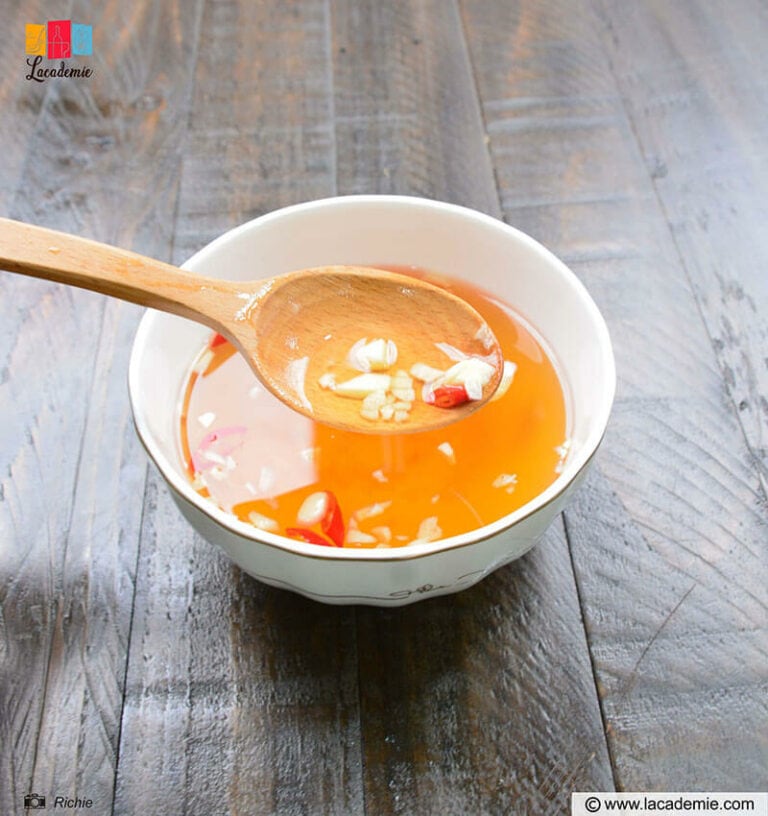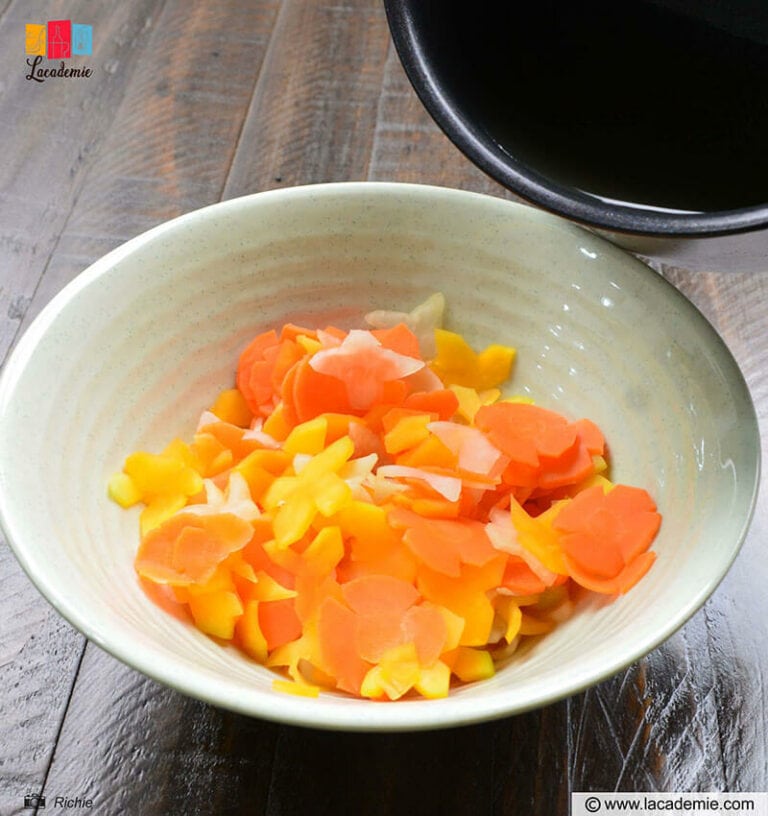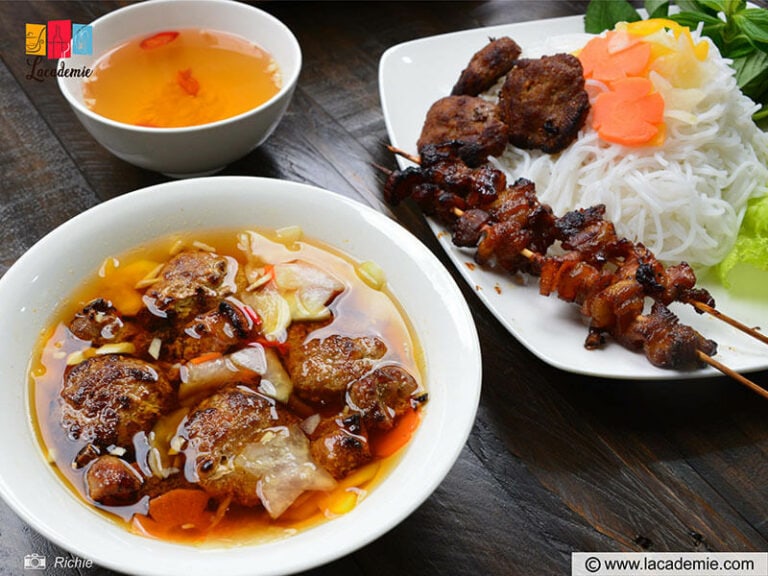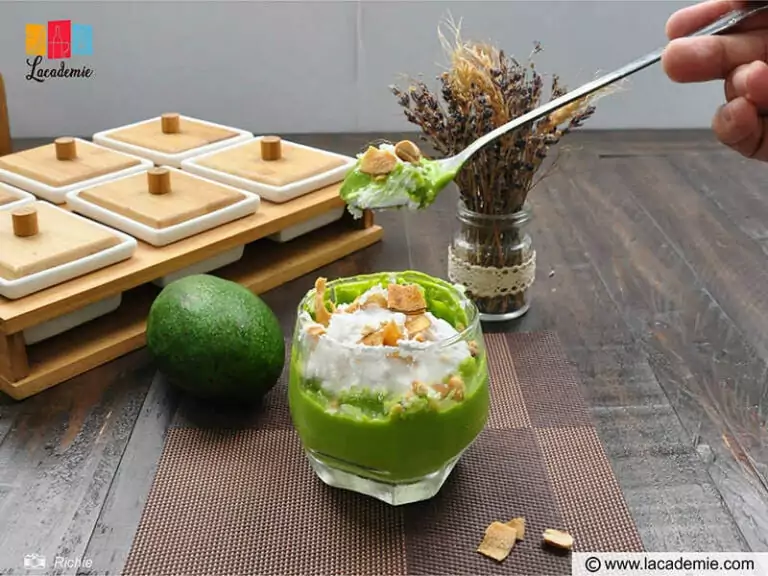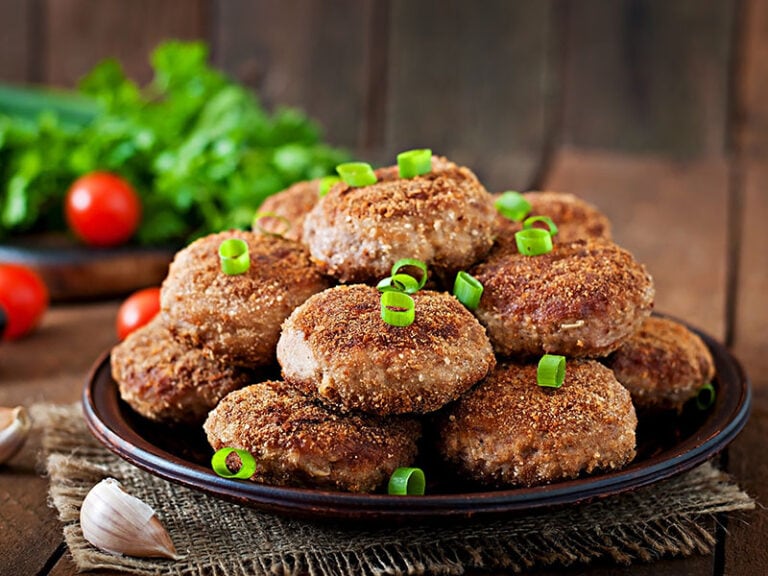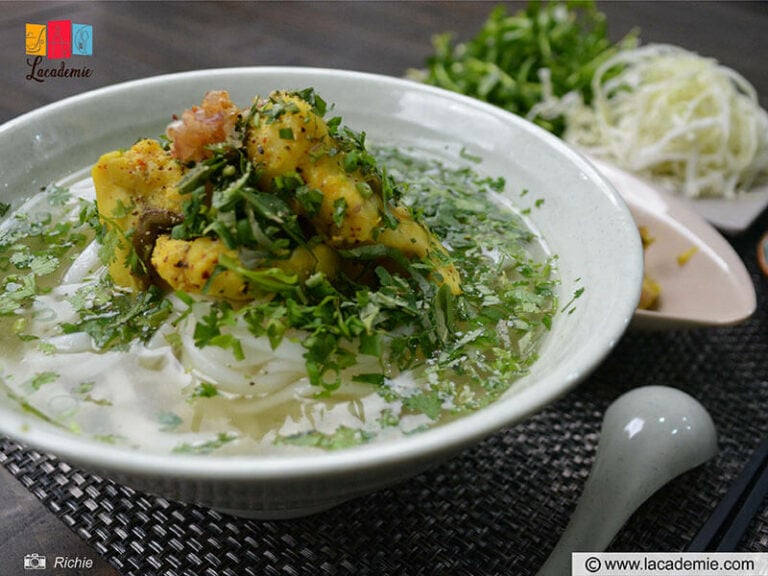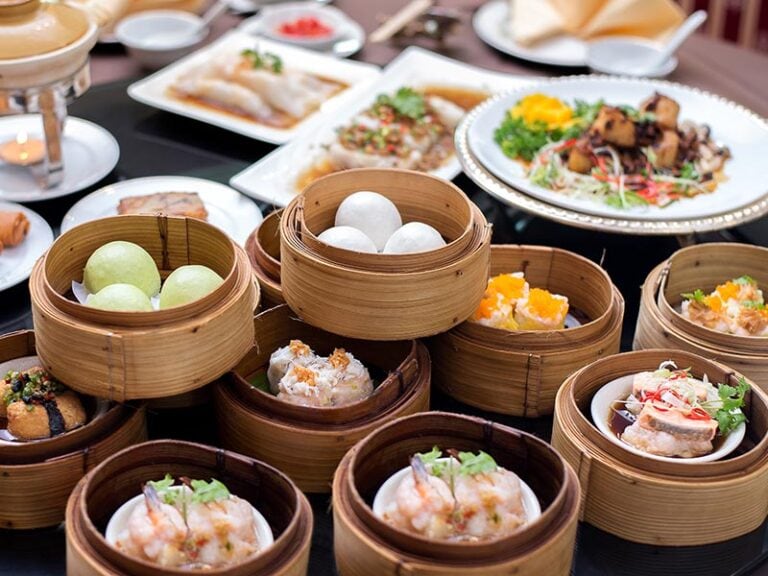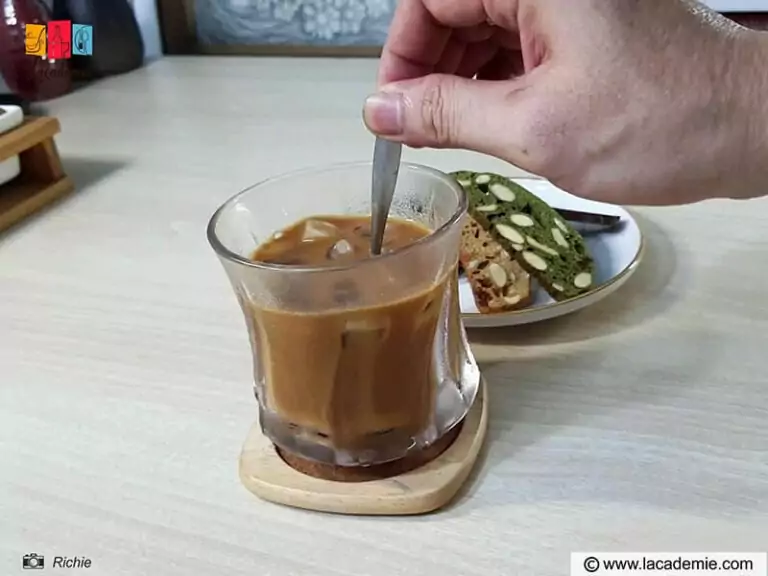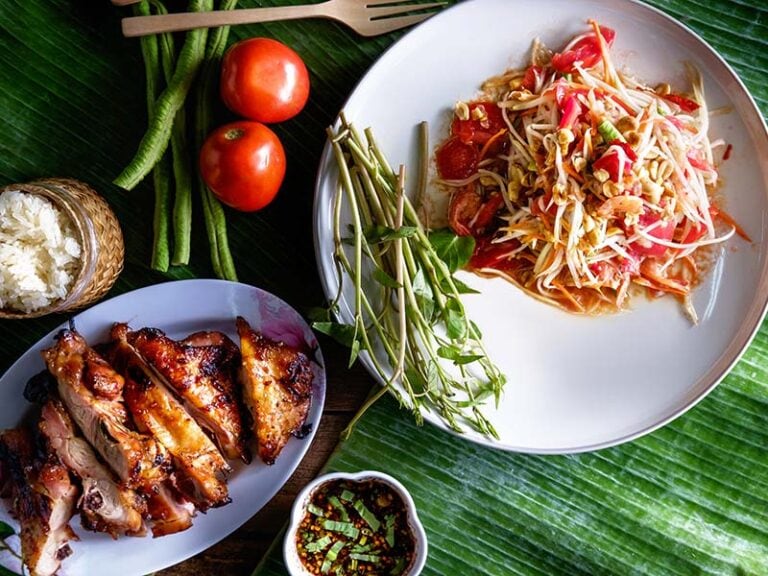If there were a dish that all Hanoiains cherish, Vietnamese grilled pork and meatballs (Bún Chả) would be that one. This Northern Vietnamese delicacy is a true culinary gem, combining meatballs flavored and cooked to perfection, vermicelli noodles, a mouth-watering fish sauce dip, and various herbs.
While the savory dip and succulent meatballs create unmatched savoriness, the aromatic herbs balance the flavor and keep the dish from being “too meaty.” And there are also vermicelli noodles, which play an important role in binding everything together.
If you haven’t given this dish a try before, there’s no better time to do so than today. Scroll down for a detailed and easy-to-follow recipe!
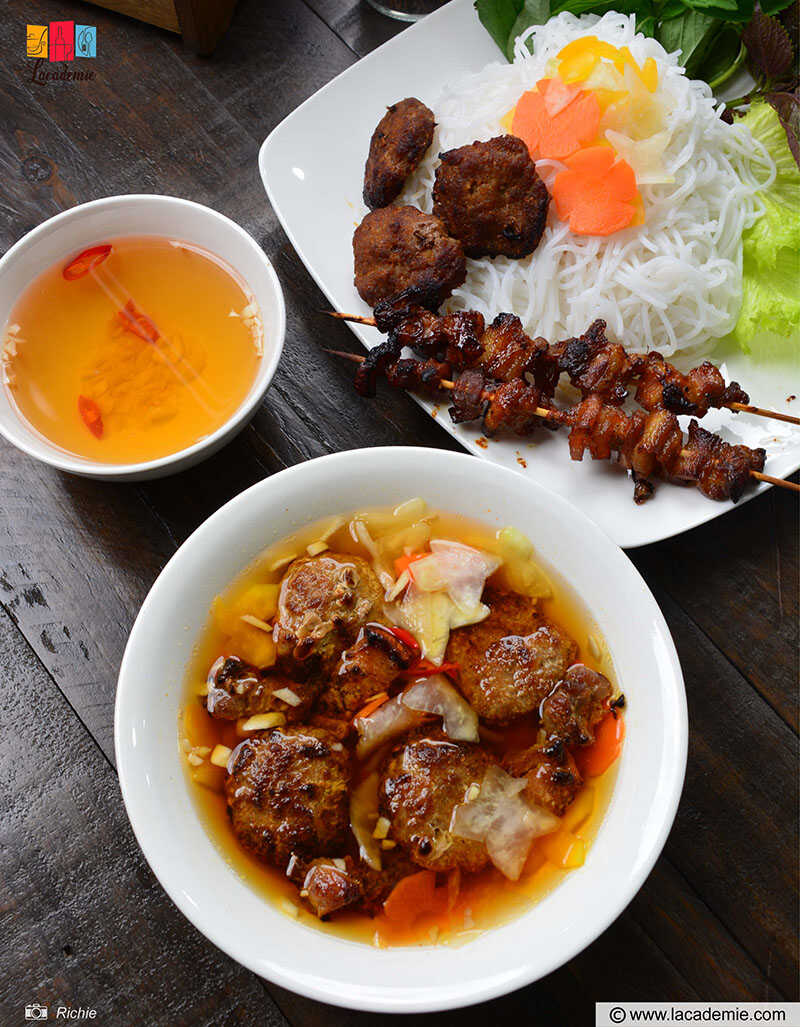
Bun Cha Vs. Bun Thit Nuong
At first sight, some people might think that Bun Cha is the Hainoi’s equivalent of Bun Thit Nuong (grilled pork noodle salad), a Southern Vietnamese classic, but this is not true.
Bun Cha is widely believed to have originated in Hanoi, the capital of Vietnam. The first restaurant to serve this dish was in Hoan Kiem District, situated in Pho Co (Hanoi’s Old Quarter). Currently, it has become a popular street treat in all of Vietnam.
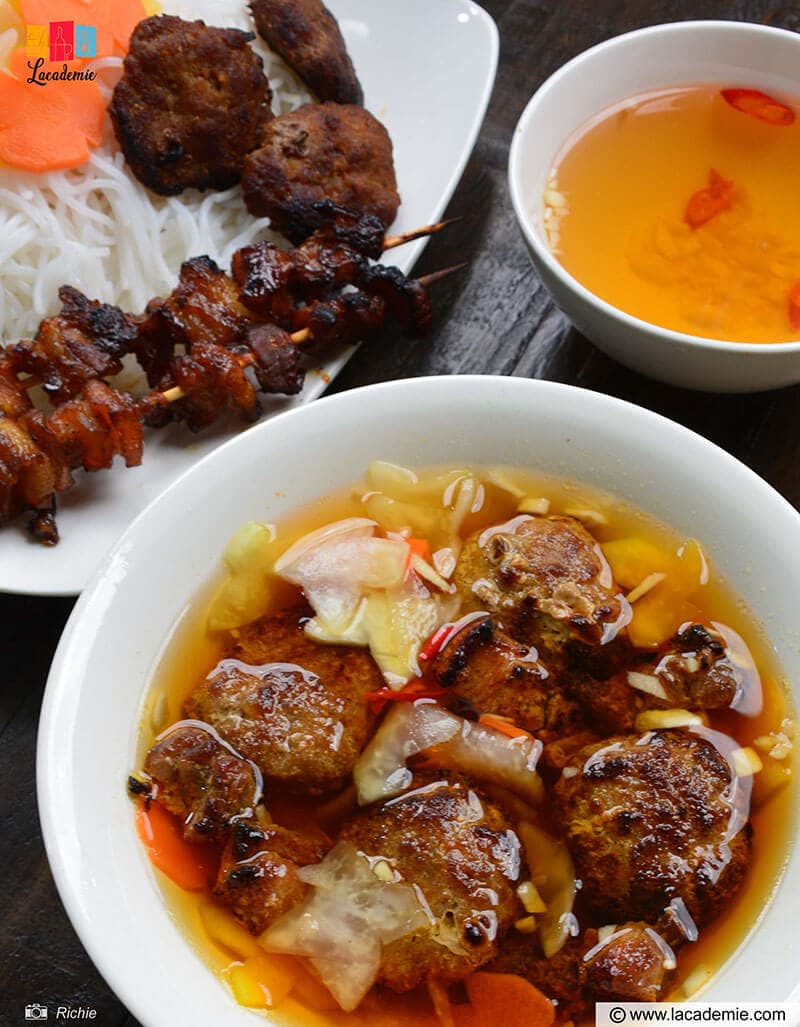
In addition to the dissimilarity in origin, Bun Cha and Bun Thit Nuong are also served differently. While the Northerners put the meatballs and pork in a bowl filled with fish sauce, people in the South typically arrange the meaty ingredients over the noodles and have a separate bowl of dip on the side.
Bun Cha has recently gained international recognition since United States former President Obama enjoyed this dish on his official visit to Vietnam. Lien Huong, where he dined, is now frequently referred to as “Bun Cha Obama.”
Tools
Making Bun Cha is not a big challenge, providing that you have all the right tools. Before getting to the actual recipe, check your kitchen for the following cookware first.
- Oven: For grilling the pork and meatballs.
- Food processor: For blending the marinade.
- Mixing bowls: For making the meatball mixture and pickles.
- Food prep gloves: For me, these gloves are a must-having when working with raw meat. They keep my hand from getting dirty and smelly. Most importantly, they also improve food hygiene.
- Bamboo skewers: For skewering the pork.
- Knives and chopping boards: Help you handle all the cutting tasks.
- Other handy tools: Sieve, basting brush, cooking oil sprayer, etc.
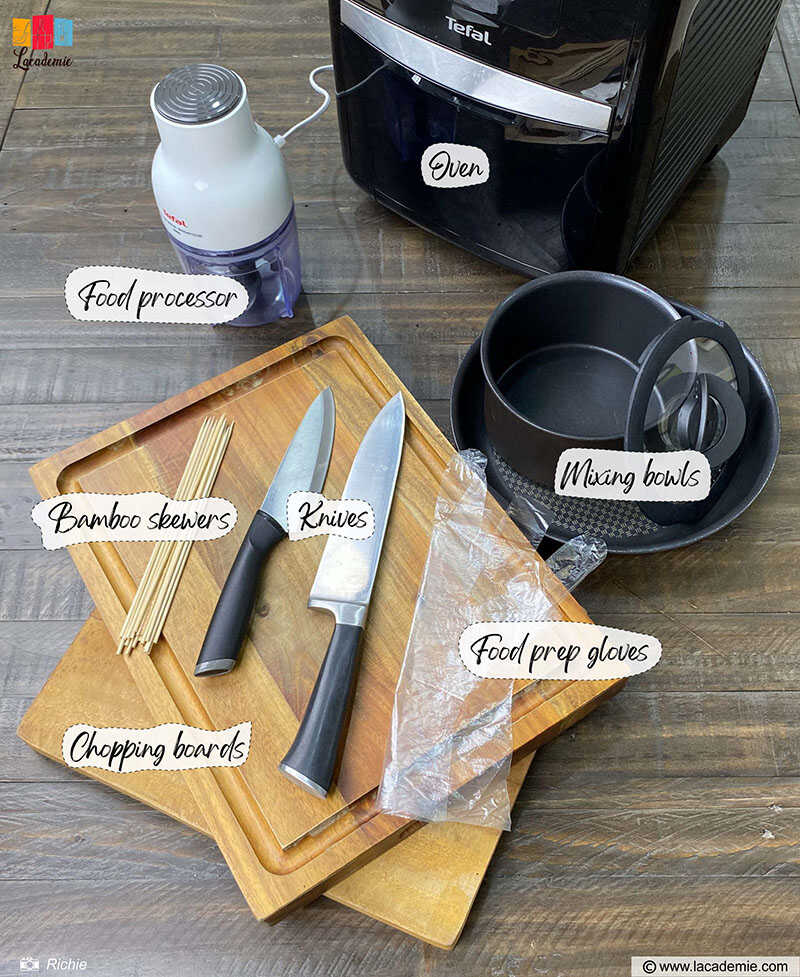
Ingredients
After getting the tool list down, it’s time to move on to the ingredients. Here is what you need to prepare.
- Pork belly: For people who prefer a leaner cut, I recommend using pork collar.
- Ground pork: Store-bought ground pork is great if you want to save time. But if you have the means, consider grinding the pork at home.
- For the marinade: Lemongrass, garlic, shallots, ground pepper, five-spice powder, salt, honey, soup powder, and condensed milk.
- Vietnamese caramel sauce (Nuoc Mau): Now, this is an ingredient that is quite hard to find outside of Vietnam. But don’t worry; you can learn how to make your own Nuoc Mau in just minutes.
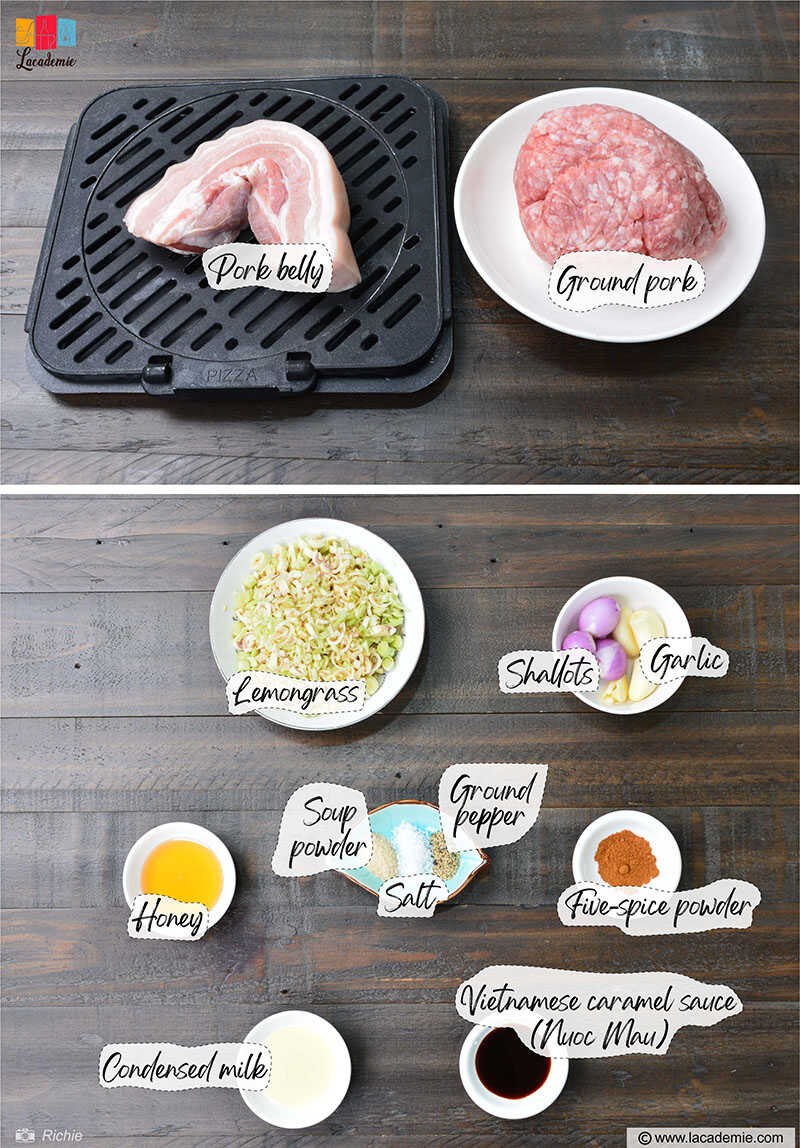
For serving
- Vermicelli noodles: Use Asian/Vietnamese vermicelli noodles, which are sometimes labeled as rice noodles. Fresh noodles are the best option, but they can be tricky to come by, so feel free to use dried noodles instead.
- For the pickles: Carrot, kohlrabi, papaya (choose fruit that’s unripe, tough, and has yellow-ish green skin for the best texture)
- For the pickle juice: Sugar, salt, vinegar,
- For the dipping sauce: Fish sauce, minced garlic, chili pepper, sugar, and lime juice
- Herbs and vegetables: Lettuce, fish mint, beefsteak plant, and peppermint.
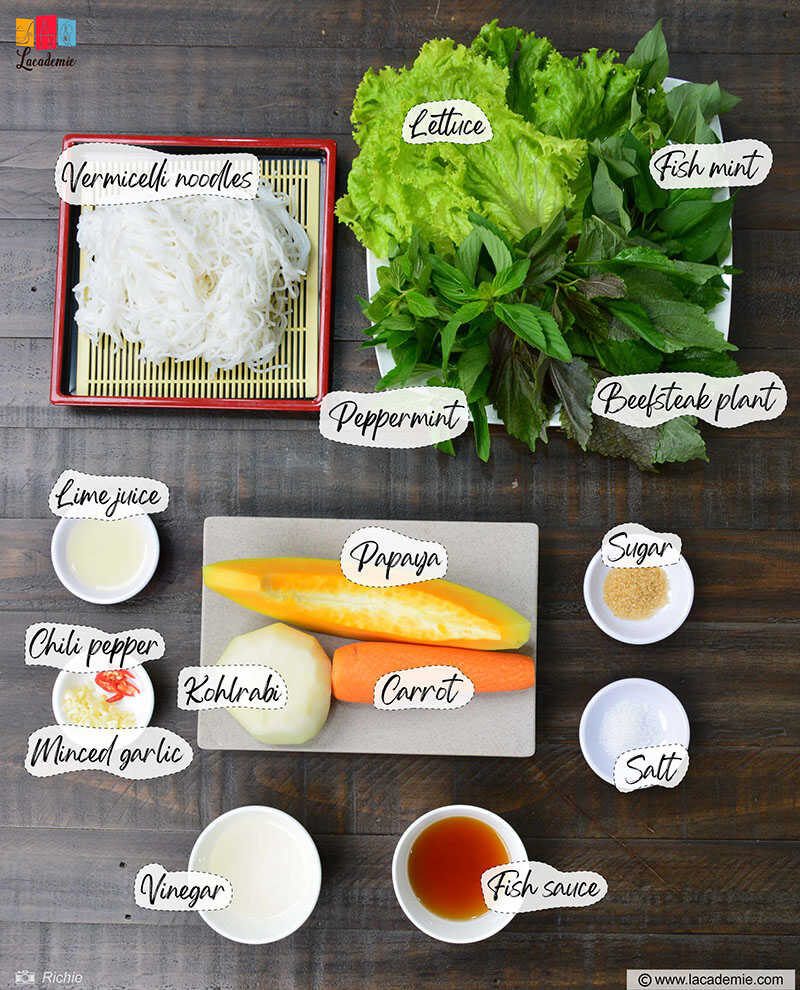
Directions
Without further ado, let’s start cooking the famous Vietnamese Bun Cha. Follow the steps closely for the best result.
Step 1: Prepare The Ingredients
Rinse and drain the vegetables and herbs.
Finely cut the lemongrass, shallots, and garlic. Then, blend them together with 0.5 cups of water using a food processor.
Put on the food prep gloves and squeeze the lemongrass mixture over a sieve to extract the juice.
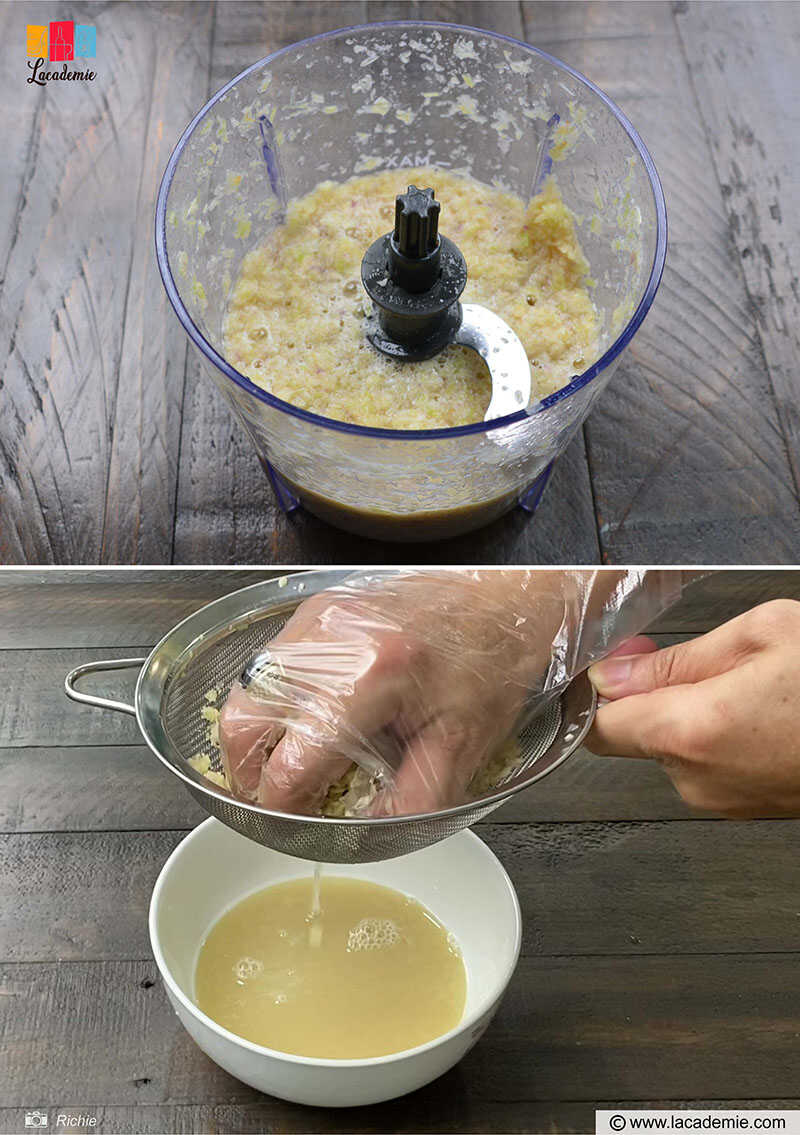
Note: You can also marinate the pork with this mixture, but I highly recommend squeezing out its juice for the best flavor.
Step 2: Marinate The Pork
Slice the pork belly into bite-sized strips (avoid cutting it too thin). Season the meat with half of the lemongrass juice, 1 teaspoon of pepper, 1 teaspoon of salt, 1 teaspoon of soup powder, 1 teaspoon of five-spice powder, 1 teaspoon of honey, 2 teaspoons of condensed milk, and 2 teaspoons of caramel sauce.
Mix well and marinate for at least 15 minutes.
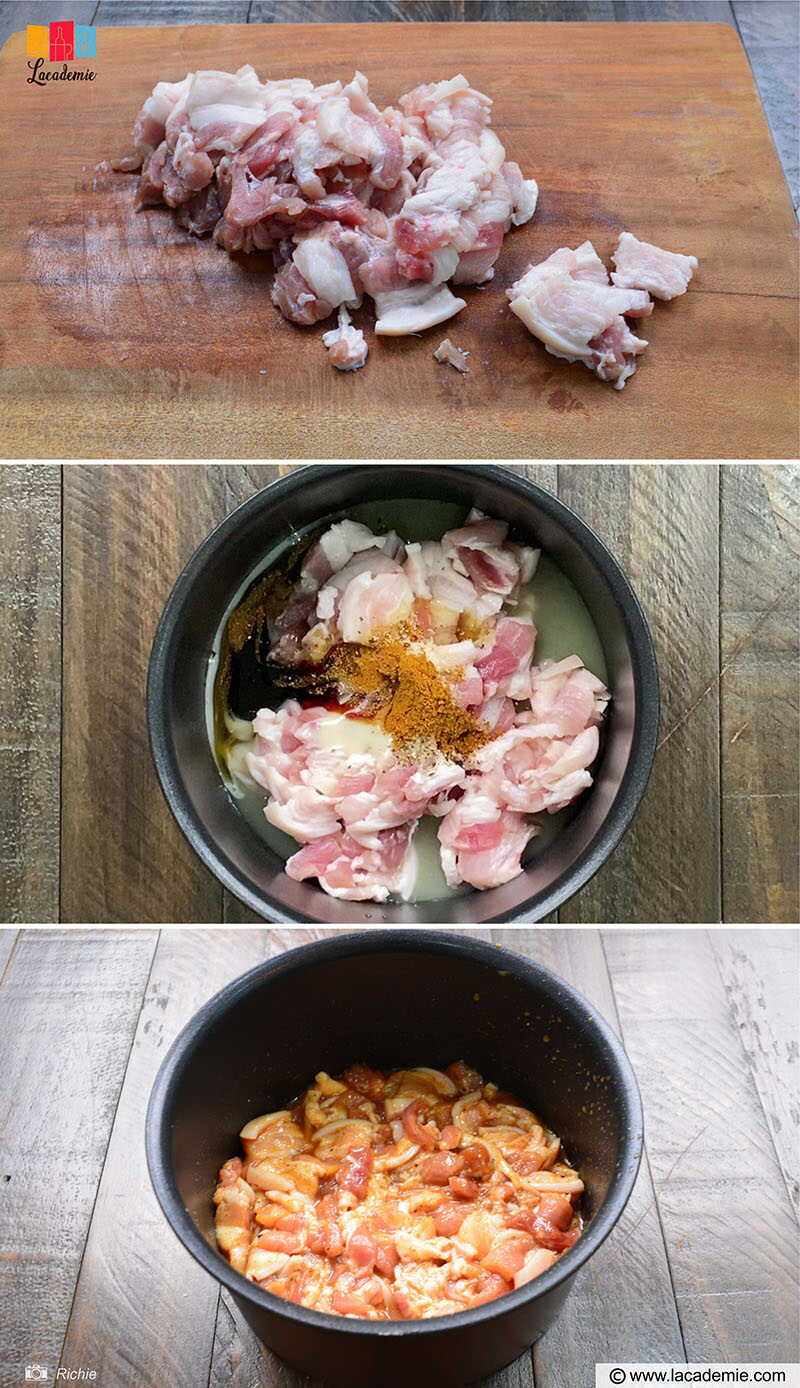
Season the ground pork with the remaining lemongrass juice and the exact same spices. Mix well and let it rest for at least 15 minutes.
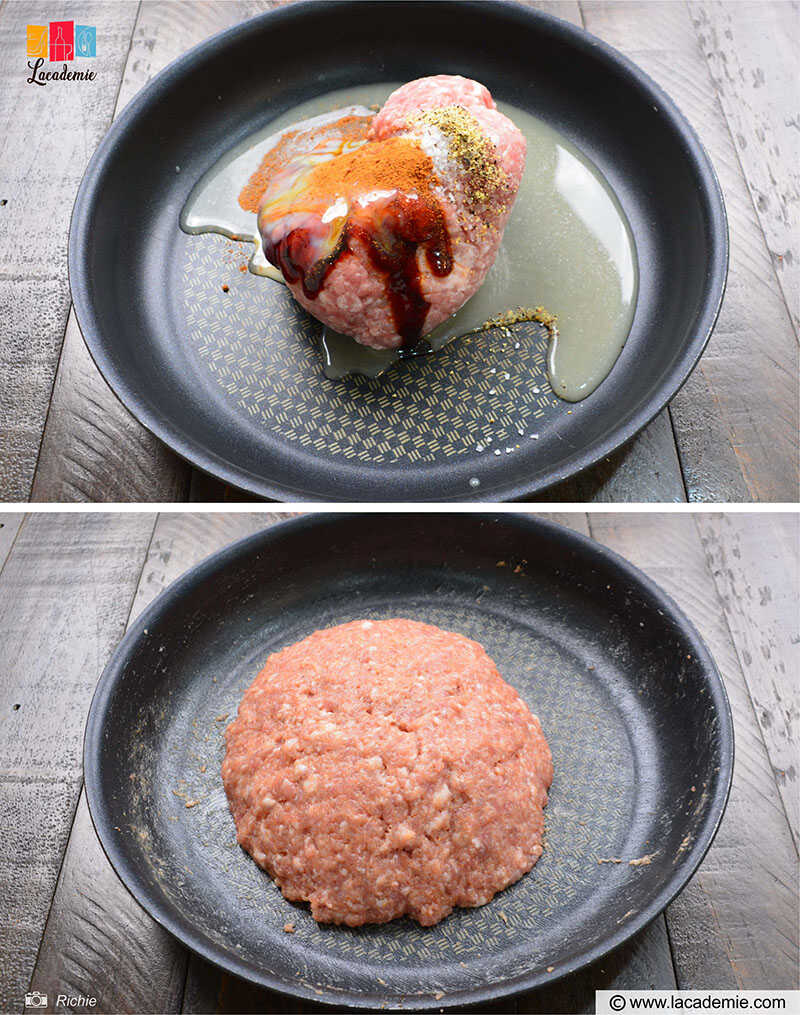
Step 3: Prepare The Pickles
Cut the carrot, kohlrabi, and green papaya into pieces, then slice them finely. You can also cut them into flower shapes if you want.
Season them with 2 teaspoons of sugar and 2 teaspoons of salt. Marinate for 15 minutes to improve their crispness.
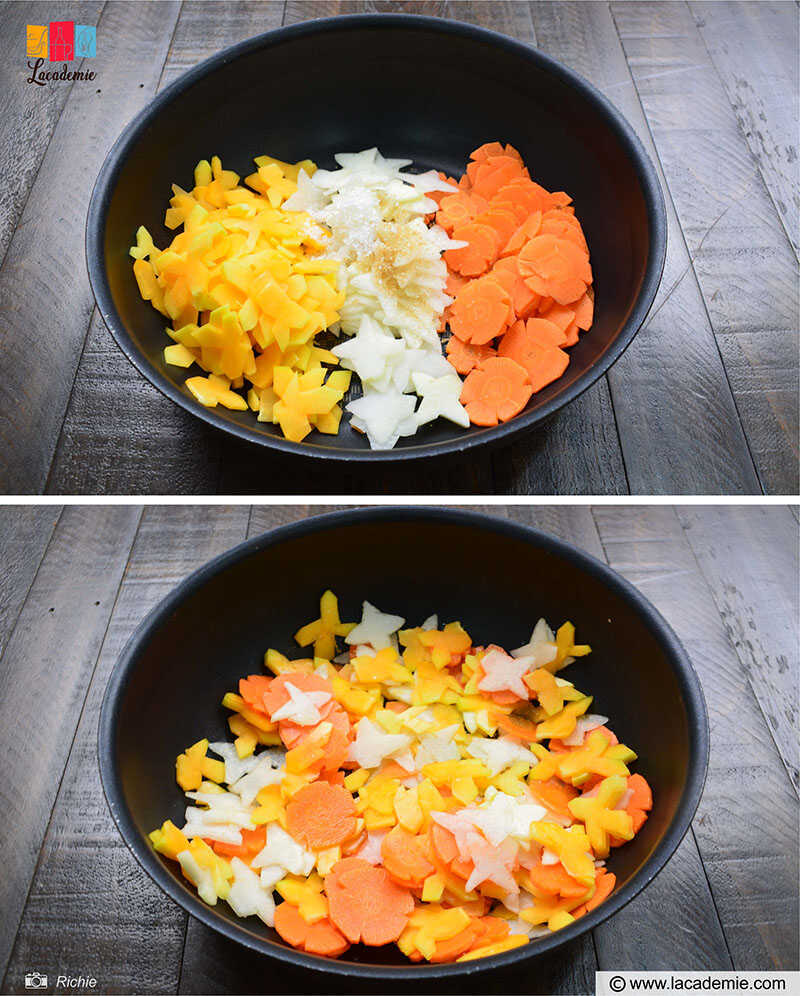
Combine 10 tablespoons of vinegar with 2.5 ounces of sugar. Bring the mixture to a boil, then let it cool.
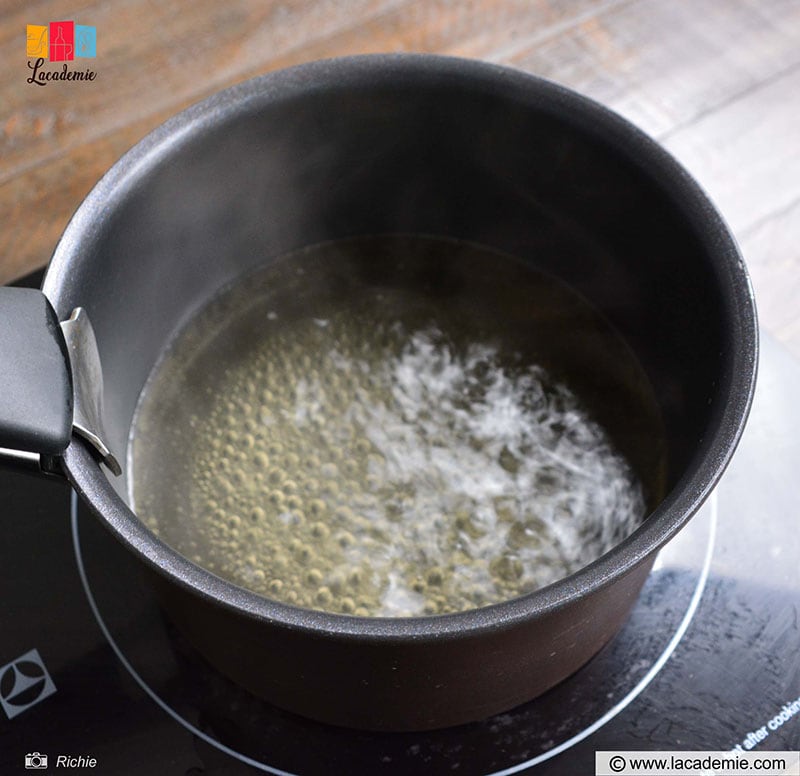
Step 4: Shape And Grill The Meatballs
After the ingredients have been well-marinated, preheat your oven to 400 degrees F. This step ensures a staple cooking temperature, helping the meat to cook more evenly.
Brush or spray a little cooking on the grilling tray to prevent the pork from sticking to it.
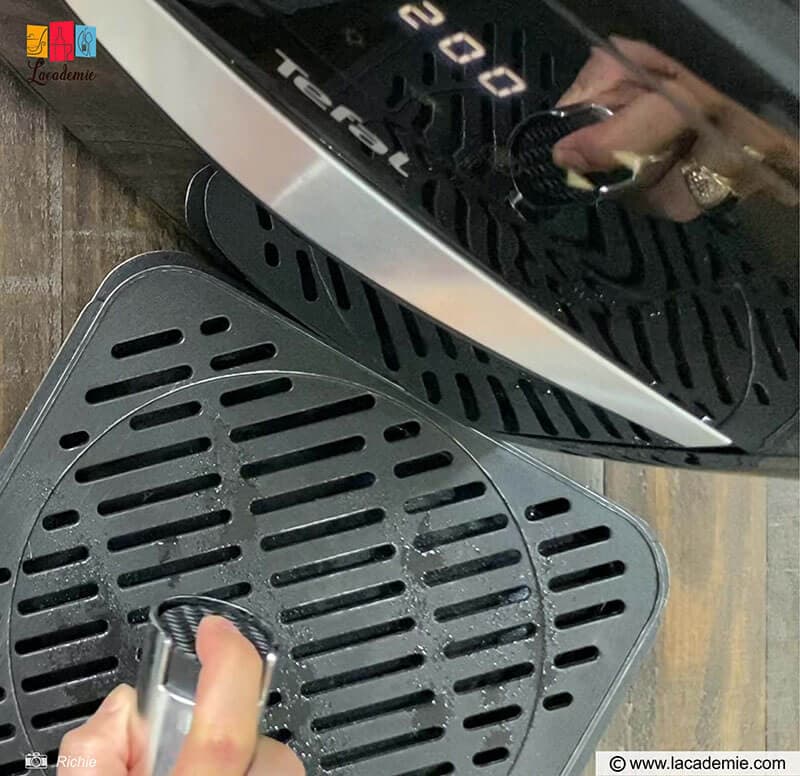
Shape the marinated ground pork into flat, round meatballs. Press the pork using your palm to get it into the perfect shape. Repeat until you run out of ground meat.
Once done, place the meatballs onto the grilling tray. Spray some oil on the meatballs to keep them from drying out.
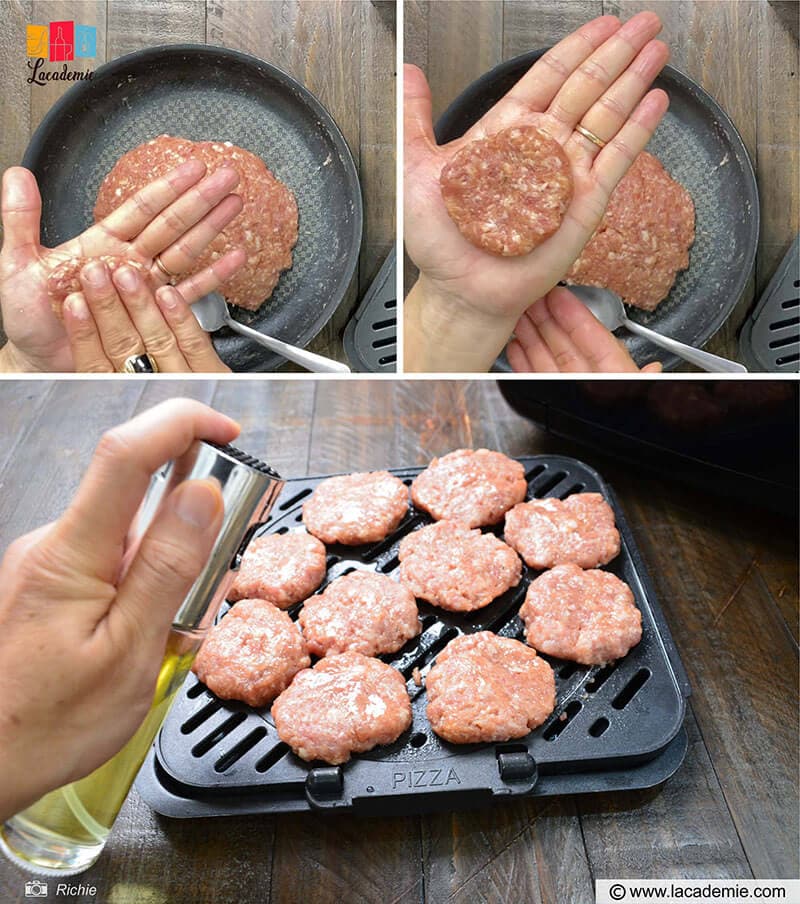
Note: Do not overload the tray. If there are too many meatballs, you should grill them in batches.
Grill the meatballs for 12 minutes at 400 degrees F.
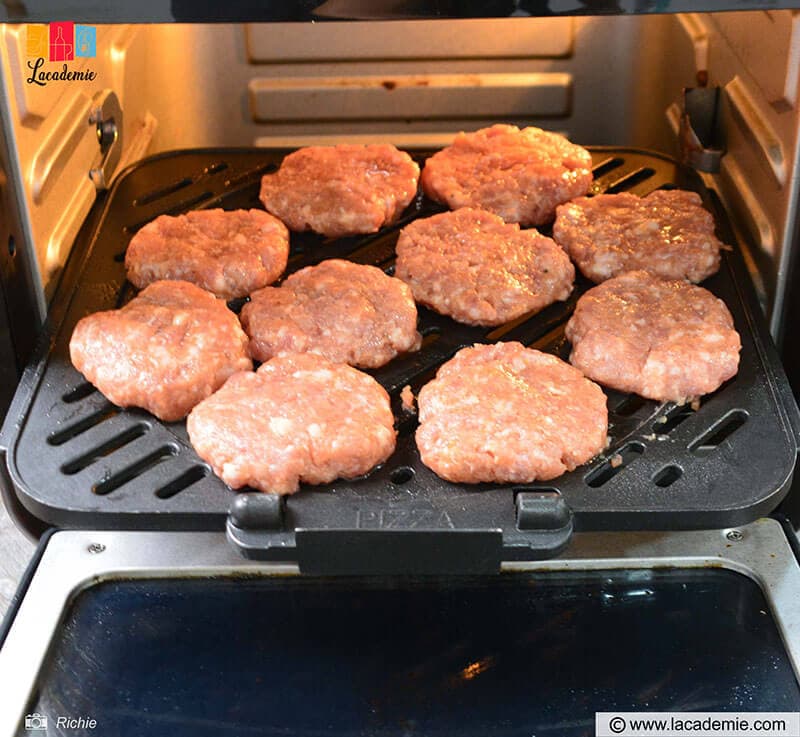
Step 5: Grill The Pork
While waiting for the meatballs to cook, thread the pork pieces into the skewers.
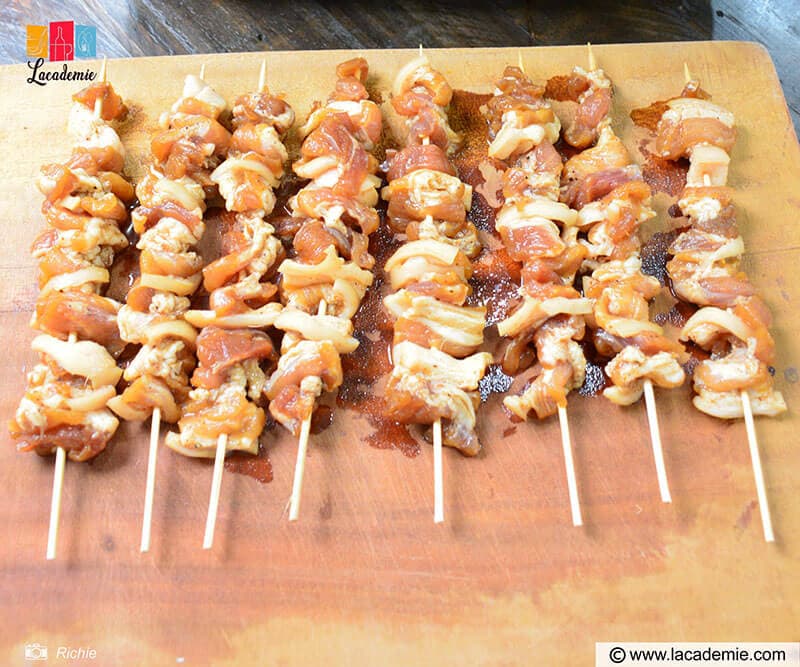
Note: You should skewer just enough meat on the sticks so that they’re not too loaded or too thin.
Once you’ve finished cooking the meatballs, time to put the pork skewers in the oven!
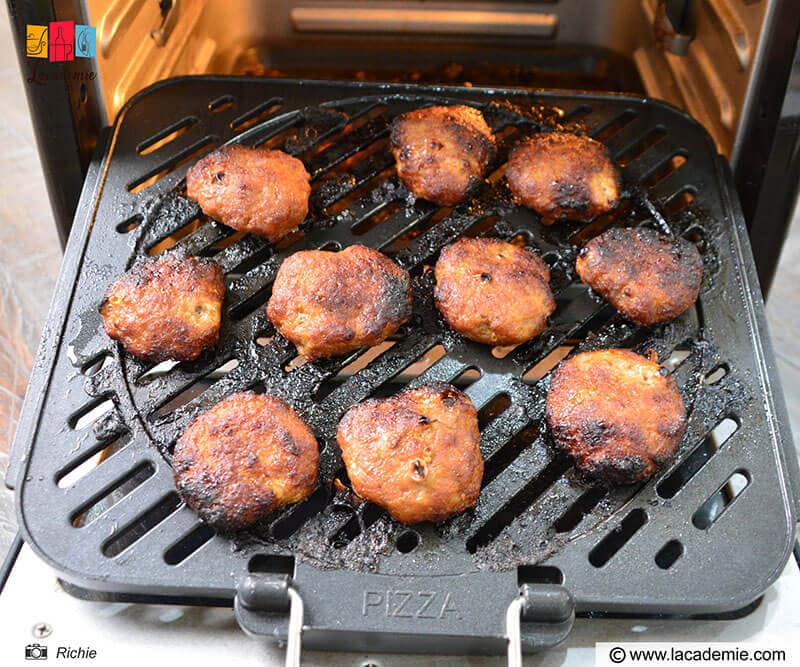
Spray a little oil on the pork’s surface to prevent them from drying out. Then, grill them for 12 minutes at 400 degrees F.
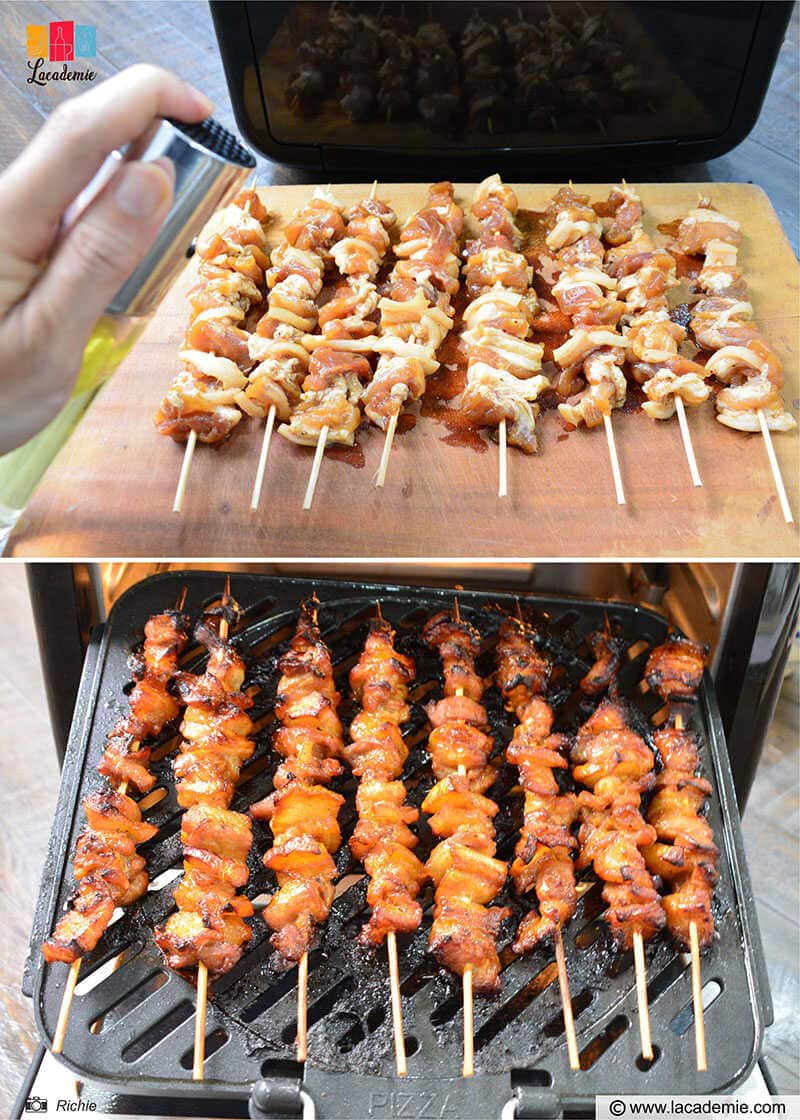
Once done grilling, transfer the pork and meatballs to a clean pot and cover it with a lid or aluminum foil.
Step 6: Make The Dipping Sauce
Combine 13.5 tablespoons of warm water with 10 tablespoons of fish sauce and 3.5 ounces of sugar. Stir well, then add garlic, chili pepper, and juice of 1 or ½ a lime. Do a taste test and adjust the spices to your liking.
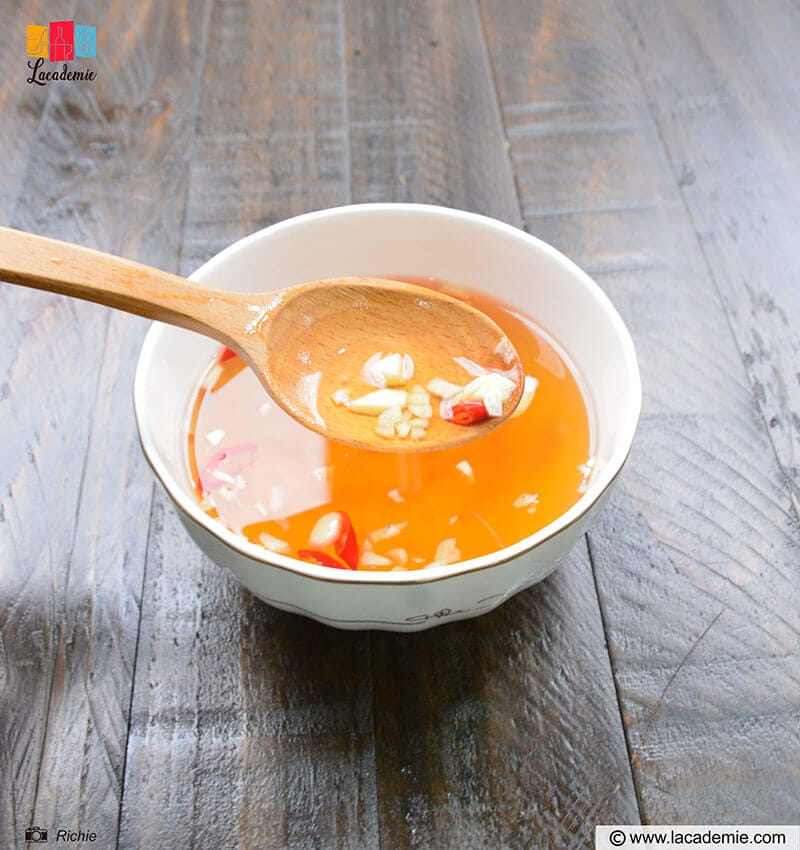
In addition, you can also serve your Bun Cha with Vietnamese traditional dipping sauce (Nuoc Cham). Making this dip requires a bit more work, though.
Step 7: Finish Making The Pickles
Put on a pair of food prep gloves. Squeeze the pickled vegetables to remove the excess liquid. Then, pour the vinegar and sugar dressing over the veggies.
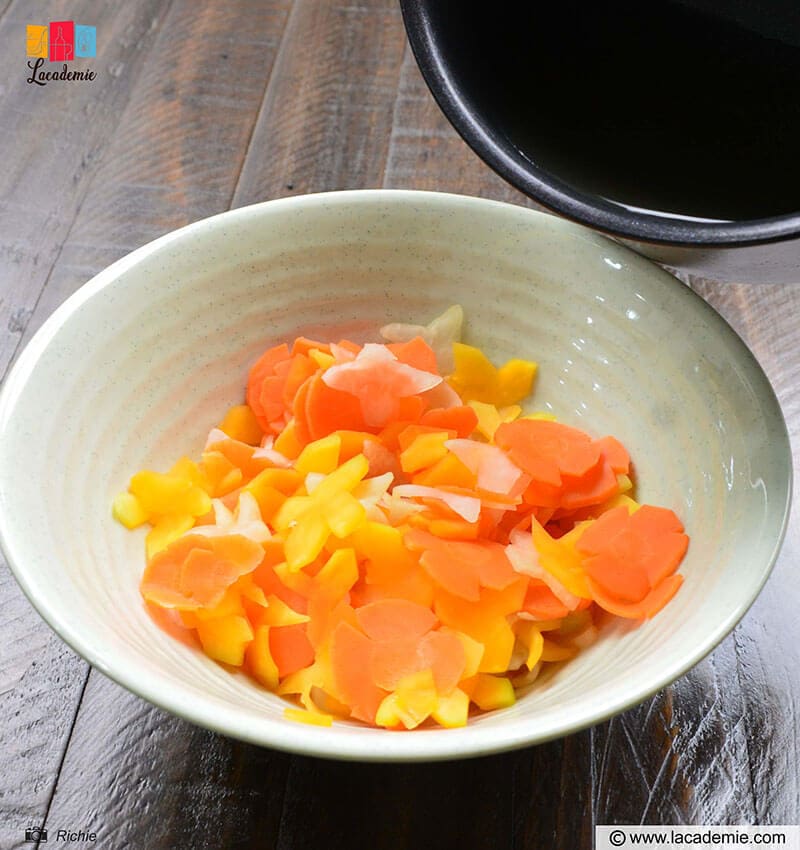
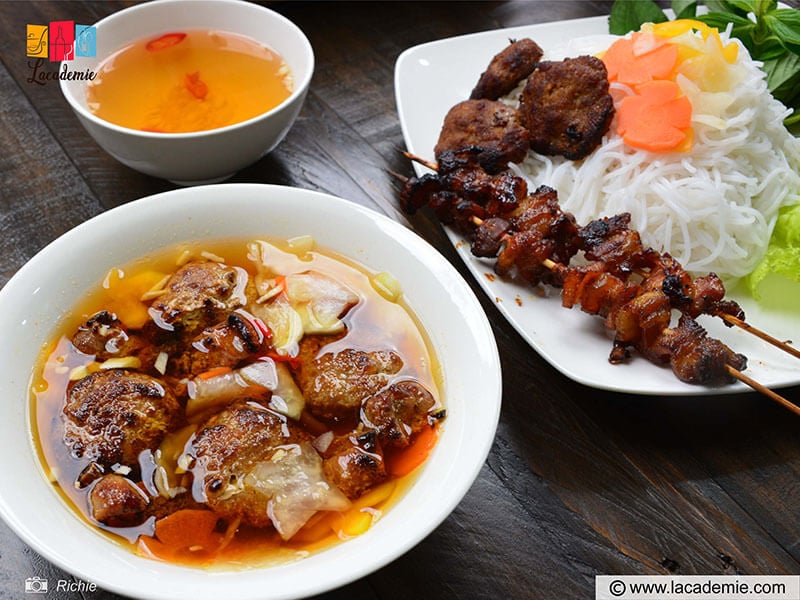
Step 8: Serve The Dish
Place the pork skewers and meatballs on a plate next to the vermicelli noodles, pickled vegetables, and herbs.
When serving, spoon the dipping sauce into a bowl together with the pork, meatballs, and pickles. Enjoy them with the noodles and herbs on the side.
How To Eat Bun Cha The Vietnamese Way
Now that you’ve completed cooking Bun Cha, let’s learn how to enjoy it like a true Hanoian. First and foremost, as with most Vietnamese dishes, you should eat them using chopsticks. These utensils are considered an essential tool in Vietnamese cuisine, so I highly recommend learning how to use them.
When it comes to serving this dish, there are typically two ways. The first way, which is also the more common one, is to pick up some noodles, dip them in the sauce, then enjoy them with meatballs and herbs.
Another way is to add the noodles, meatballs, and herbs into a serving bowl, then pour in some sauce. This is somewhat similar to how the Vietnamese normally eat Bun Thit Nuong.
In addition, the locals love to order some Cha Gio (Vietnamese egg rolls) to eat with their Bun Cha. The crispy rolls go really well with the savory dip and vermicelli noodles, so you should definitely give them a try!
The Best Way To Store Bun Cha
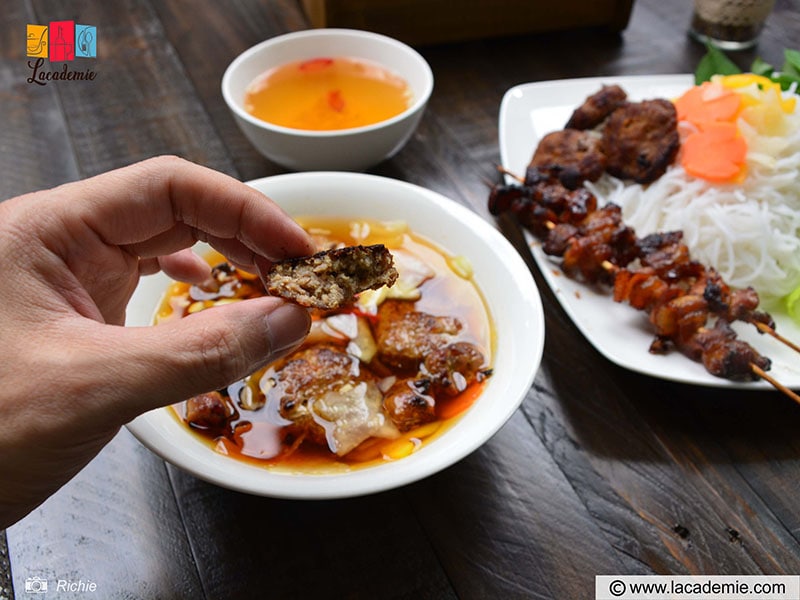
Bun Cha consists of four main components: the dipping sauce, the vermicelli noodles, the grilled pork and meatballs, and the pickles. For the longest shelf life, you should store them in different airtight containers.
If you’re using dried noodles, it’s best that you store them as instructed on the package (provided that you haven’t cooked them yet). For blanched or fresh noodles, put them in a box/container and refrigerate. They last about 2 to 3 days.
Likewise, place the grilled pork and meatballs in a container and refrigerate for up to 3 days. If you want, you can also freeze them for up to 3 months.
Since the dipping sauce doesn’t take a long time to make, I often make a new batch before eating. But if you need to store it, simply pour it into a sealed glass jar, then refrigerate. It will generally last for about 2 weeks.
Note: In case you want to store the dipping sauce, ensure that you don’t touch it with used utensils.
As for the pickles, you can actually store them for up to 1 month by putting them in a closed jar. Be mindful that their flavor will get more intense over time.
Tips And Tricks
At this point, I believe that you’ll be able to whip up Vietnamese Bun Cha with ease. That said, don’t skip these tips and tricks, as they might be more useful than you think!
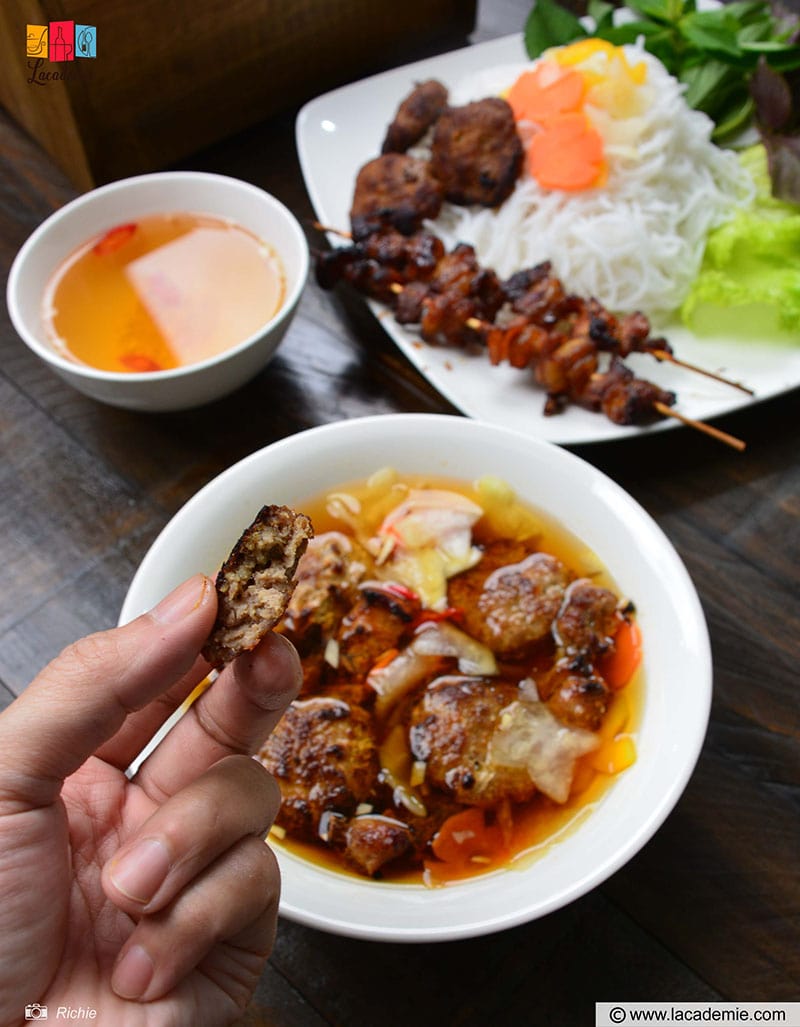
- I’ve tested and adjusted the seasonings so that most people will find this dish enjoyable. However, feel free to switch up the amount used to suit your taste preference.
- Honey is a must-have ingredient for the most authentic Bun Cha. That said, don’t use too much honey, as it will make your meatballs and pork more prone to being burned.
- If you have the time, try grilling the meat over charcoal to infuse them with a unique smoky taste.
FAQs
Before ending the post, I have also collected some frequently asked questions regarding Bun Cha. Give them a read to learn more about this Vietnamese dish.
Don’t Miss This Chance To Try Out A Hanoian Delicacy
Bun Cha is the pride of Northern Vietnamese cuisine and is a dish that every true foodie should try at least once. With today’s recipe, you can now make and enjoy this delicious delicacy without having to eat out!
What are your thoughts on Bun Cha? Between Bun Cha and Bun Thit Nuong, which one do you like better? Drop a comment to let me know what you think about this recipe! Also, kindly like and share this post if you enjoy it. Have a great time cooking!
Nutrition Facts
4 servings per container
- Amount Per ServingCalories978
- % Daily Value *
- Total Fat
24.1g
37%
- Saturated Fat 10.4g 50%
- Cholesterol 145mg 49%
- Sodium 2438mg 102%
- Potassium 503mg 15%
- Total Carbohydrate
118.4g
40%
- Dietary Fiber 5.4g 20%
- Sugars 10.1g
- Protein 62.5g 124%
- Calcium 91%
- Iron 5%
* The % Daily Value tells you how much a nutrient in a serving of food contributes to a daily diet. 2,000 calories a day is used for general nutrition advice.


